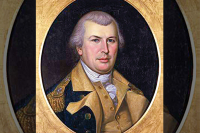An ongoing preservation
This past week, we took our 11-year-old granddaughter, Daisy, who is visiting from Colorado, to the Cherokee Indian Village. She had been reading about the Cherokees and wanted to see “real Indians.” The tour was excellent. There were plenty of “real Indians.” We were lucky in that the Cherokees were holding a special dance ceremony to which the public was invited. Chief Michell Hicks was there and he danced, fairly well.
Daisy didn’t dance because she wanted to observe. She saw the bear dance, the quail dance, the friendship dance, and several others. The Cherokees in attendance were in a good mood. They especially enjoyed watching a teacher try to organize his kids — who looked to be 5 or 6 years old — into a disciplined covey of baby quails. They were about as organizable as a real covey of baby quails. But they were cute.
That evening, we talked some about Cherokee dance and other traditions. I told Daisy about Will West Long, one of my favorite Cherokees. The Cherokees of today are obviously keeping their traditions alive as much as possible. It was Will West Long who kept them alive 100 years ago.
He was born in the Big Cove area about 1870, the son of a Baptist minister, John Long, and Ayasta (Sally Terrapin). As was normal in traditional Cherokee society, the mother’s side of the family assumed responsibility for the rearing of children. The anthropologist James Mooney, who lived in Cherokee periodically from 1897-1890 collecting their lore, noted that Ayasta was “one of the principal conservatives among the women.” (I showed Daisy a photo of Ayasta in Mooney’s book.) Ayasta initiated Will into an understanding of tribal lore that subsequently withstood numerous brushes with acculturation.
After several lonely sojourns at Trinity College near High Point, Will returned to the Qualla Boundary and settled down to farming while learning more about the sacred formulas and other traditional lore from the conjurers and medicine men.
When Mooney arrived in the Big Cove in 1887, he felt an immediate attraction to Long — then a teenager working with the medicine man Swimmer — and hired him as a scribe and interpreter. Even after Mooney mastered the language himself, the two remained close friends.
Related Items
Until several years before his death in 1921, Mooney periodically visited Will and other members of the Long family in the Big Cove. On one such occasion in 1913, he was invited to take place in a “going to water” ceremony commemorating the birth of a son. The entire family arose before sunrise, prayed, and then walked two miles to a special mountain stream. While Will West Long faced the rising sun, held forth colored beads, and invoked the Long Man (the designation for a stream in Cherokee mythology as it was a giant with its head in the mountains and its feet in the ocean), everyone else waded with the newborn child into the sacred water.
As a result of Mooney’s influence in the late 1880s, Will once again enrolled in an institution of higher learning. This time it was Hampton Institute. He subsequently spent 10 years in New England, learning and observing the dominant culture. The exposure didn’t take. Dissatisfied with that lifestyle, he returned in 1904 just prior to Ayasta’s death and seldom ventured away from the Big Cove again.
Having seen and experienced other possibilities, Will found that a white education had had little influence on the traditional spiritual lessons learned as a child from his mother. He began collecting notebooks from tribal conjurors that contained the ancient sacred chants and charms. He would on occasion appear suddenly at the Cherokee schools and captivate the children with tales and chants from their shared tribal past. Adept at all of the traditional Cherokee modes of expression — storytelling and dancing and singing — he was also the Eastern Band’s foremost authority on medicinal plants. Almost single-handedly, he kept the tradition of ceremonial mask carving alive.
He taught the old ways to the young people. Among these was his nephew Walker Calhoun. As a child Walker danced to the ceremonial singing of his uncle. The singing and dancing captured the boy’s imagination. Before he was 9, Walker could sing all of the old songs and dance all of the old dances.
I was pleased that Daisy, who has developed an interest in Cherokee ways, had a chance to see them dance some of the old dances kept alive by Swimmer, Ayasti, Will West Long, Walker Calhoun, the Raven Rock Dancers, and the school teacher last week who was doing his absolute best to organize that covey of Indian children for a quail dance.
George Ellison wrote the biographical introductions for the reissues of two Appalachian classics: Horace Kephart’s Our Southern Highlanders and James Mooney’s History, Myths, and Sacred Formulas of the Cherokees. In June 2005, a selection of his Back Then columns was published by The History Press in Charleston as Mountain Passages: Natural and Cultural History of Western North Carolina and the Great Smoky Mountains. Readers can contact him at P.O. Box 1262, Bryson City, N.C., 28713, or at This email address is being protected from spambots. You need JavaScript enabled to view it..









